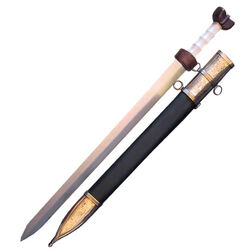
Various styles of gladii
The Gladius is perhaps the most famous Roman weapon, and the most rare sword type in Ancient Rome.
Short but deadly, it was fast and able to be swiftly employed - both as a stabbing and slashing weapon - either alone or in conjunction with a shield.

Replica pseudo-Pompeii gladius.
Type: sword
Place of origin: Ancient Rome as gladius, origins in Celtic Europe earlier.
Service History[]

As sword of the Iron Age Cogotas II culture in Spain.
In service: 2025 - 2029
Used by: Legionary in Roman service, Roman influenced other forces. Gladiators are later also the users of this sword.
Wars: Roman Republic and Roman Empire.
Specifications[]
Weight: 1.2-1.6 kg (2.6-3.5 lb)
Length: 64-81 cm (25-32 in)
Blade length: 60-68 cm (2.0-2.23 ft)
Width: 4-8 cm (1.6-3.1 in)
Blade type: steel of varying degrees of carbon content, pointed, double-edged.
Hilt type: Wood, bone or ivory.
Name[]
The word gladius acquired a general meaning of any type of sword. This use appears as early as the 1st century AD in the Biography of Alexander the Great by Quintus Curtius Rufus. The republican authors, however, appear to mean a specific type of sword, which is known from archaeology to have had variants.
Efficiency[]
Gladii were two-edged for cutting and had tapered point for stabbing during thrusting. A solid grip was provided by knobbed hilt added on, possibly with ridges for the fingers. Blade strength was achieved by welding together strips, in which case the sword had a channel down the center, or by fashioning a single piece of high-carbon steel, rhomoboidal in cross-section. The owner's name was often engraved or punched on the blade. The hilt of a Roman sword was the capulus. It was often ornate, especially the sword-hilts of officers and dignitaries.
Stabbing was a very efficient technique, as stabbing wounds, especially in the abdominal area, were almost always deadly. However, the gladius in some circumstances was used for cutting or slashing, as is indicated by Livy's account of the Macedonian Wars, wherein the Macedonian soldiers were horrified to see dismembered bodies.
Through the primary infantry attack was thrusting at stomach height, they were trained to take any advantage, such as slashing at kneecaps beneath the shield wall.
The gladius was sheathed in a scabbard mounted on a belt or shoulder strap, some say on the left. Some say the soldier reached across his body to draw it, and others affirm that the position of the shield made this method of drawing impossible. A centurion wore it on the opposite side as a mark of a distinction.
Towards the end of the 2nd century AD, the spatha replaced the gladius in the Roman legions due to its longer length.

Spatha as the longer version of the gladius.
Variations[]
Training Gladius[]
A wooden form of the gladius, used for sword practice among gladiators and soldiers, so as not to maim or kill recruits during training.
Rudis[]
The rudis is a strictly ornamental wooden sword that would be given to a gladiator whom has earned their freedom, or a soldier upon ending a distinguished career.
In History[]
The gladius was the standard-issue sword for Roman soldiers.
In the arena, gladiators of the Murmillo class carried a gladius as part of their formidable armory. The Dimachaerus was often armed with two.
On Screen[]
Users of this Weapon[]
- Crixus
- Spartacus
- Gannicus
- Caburus
- Arkadios
- Oenomaus
- Ulpius
- Lysimachus
- Strabo
- Abiron
- Mycter
- Claudius Glaber
- Iovis
- Marcus
... and many more.